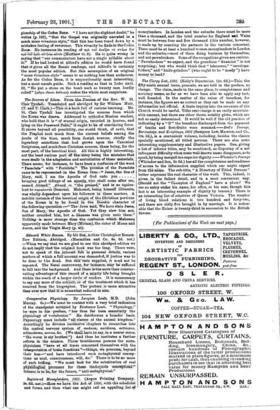The Sources of /slam. Prom_tha-Pexsian, of the Rev. W. St.
Clair .Tysclall.- Translated, and abridged. by Sir. William Muir, ('r. and T. Clark.)-his is a book full of curious learning. Mr. St. Clair Tysdall has investigated the sources from which the Koran was drawn. • Addressed to orthodox Moslem readers, who hold that it is " of eternal origin, recorded in heaven, and lying on the Preserved.Table,'.' it ought to be of convincing force. It shows beyond all possibility, one would think, of cavil, that the Prophet _took much from the current beliefs among the Arabs of the time, much from Jewish sources, chiefly the legendary accretions that had grown upon the Canonical Scriptures, and much from Christian sources, these being, for the most part, of the heretical kind. All this is highly interesting, not the least curious part a. ethe-itery -being the mistakes that were made in the-adaptation and assimilation of-these- materials. There seems,' for instance, to hare been a confusion of the word " Paraclete " with " Perielete.". The rheiise of the Paraclete
came to-he represented-in the- Koran. thus J436e31 the- Son-of
Mary, said, I am the Apostle of God unto you bringing good tidings of an _apostle who _shall come after me, named_ Ahmd Ahmed = the praised,' and is- so -equiva- lent to repot/U*4s (famous). Mahomet, being himself illiterate, was'wholly dependent upon his followefs 1n these matters. A notable instance of the heretical origin of the•Christian portions of the Koran i1 to be 'found in the Bocetic character of the following quotation :-" The ' Jews Mid, We have slain Jesus, Son of Mary, -the Apostle of God: .• Yet they slew- him not, neither crucified him, but alikeness .was given unto them." Nothing hi-- more strange than the- confusion- which-Maine:net apparently made between Mary (Miriam); the sister of Moses and Aaron, and the Virgin Mary (p. 49).






































 Previous page
Previous page